![]()
![]()
![]()
Use LEFT and RIGHT arrow keys to navigate between flashcards;
Use UP and DOWN arrow keys to flip the card;
H to show hint;
A reads text to speech;
159 Cards in this Set
- Front
- Back
|
Like nervous tissue, muscles are excitable or "irritable”
they have the ability to respond to a? |
stimulus
|
|
|
What is a protein that functions in the contractile system of skeletal muscle, where it is found in the thin filaments?
|
Actin
|
|
|
Unlike nerves, however, muscles are also?
|
Contractible
Extensible Elastic |
|
|
What is the contractile protein that makes up the thick filaments of muscles fibers?
|
Myosin
|
|
|
The four main functions of muscles are to?
|
Create motion, Stabilize body positions and maintain posture, Store substances within the body using sphincters, Move substances by peristaltic contractions, and Generate heat through thermogenesis.
|
|
|
Sarcomeres are multi-protein complexes composed of three different filament systems. The thick filament system is composed of ____ protein which is connected from the M-line to the Z-disc by?
|
myosin, titin
|
|
|
The Three Types of Muscular Tissue are?
|
Skeletal, Cardiac, and Visceral
(smooth muscle). |
|
|
The thin filaments of a Sarcomere are assembled by ____ monomers bound to nebulin, which also involves tropomyosin (a dimer which coils itself around the F-actin core of the thin filament) and troponin.
|
actin
|
|
|
What kind of muscle is Striated, multi-nucleated (eccentric), with parallel fibers?
|
Skeletal
|
|
|
Troponin and tropomyosin are what kind of proteins?
|
regulatory proteins
|
|
|
What kind of muscle is striated, with one central nucleus?
|
Cardiac
|
|
|
What is a regulatory protein that is a component of the thin filaments? When Calcium (Ca2+) IONS bind to this protein, it changes shape. This change in shape moves tropomyosin away from myosin-binding sites on actin molecules, and muscle contraction subsequently begins as myosin binds to actin.
|
Troponin
|
|
|
What kind of muscle has no striations, and one central nucleus?
|
Visceral
(smooth muscle). |
|
|
What is a regulatory protein that is a component of the thin filaments? When skeletal muscle fiber is relaxed this protein covers myosin binging sites on actin molecules.
|
Tropomyosin
|
|
|
When a skeletal muscle fiber is stimulated at a rate of 20 to 30 times per second the result is a sustained but wavering contraction called?
|
Unfused tetanus
|
|
|
When a skeletal muscle fiber is stimulated at a rate of 80 to 100 times per second the result is a sustained contraction called?
|
fused tetanus
|
|
|
What is One of the twelve pairs of nerves that leave the brain; pass through the foramina in the skull; and supply sensory and motor neurons to the head neck and part of the trunk, and viscera of the thorax and abdomen?
|
Cranial Nerve
|
|
|
What is an organ having nerve endings (in the skin or viscera or eye or ear or nose or mouth) that respond to stimulation?
|
sensory receptor
|
|
|
Nerves called the ____ ____, branch off the spinal cord and pass out through a hole in each of the vertebrae called the Foramen. These nerves carry information from the spinal cord to the rest of the body, and from the body back up to the brain.
|
spinal nerves
|
|
|
Within opposing pairs, the ____ ____, is the muscle primarily responsible for causing the desired movement.
|
prime mover
|
|
|
The prime mover is known as the?
|
agonist
|
|
|
List The organization within a skelatal muscle from outer to inner.
|
Skeletal, Fascile, Muscle Fiber, Myofibril, and Filaments
|
|
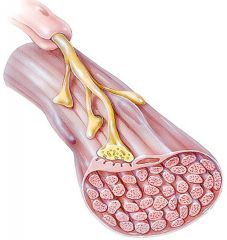
The vein like structure in this image is called the ____ while the membrane surrounding the muscle fibers is called the ____.
|
Motor Neuron, Sarcolemma
|
|
|
The ____ stretches and yields to the effects of the prime mover.
|
antagonist
|
|
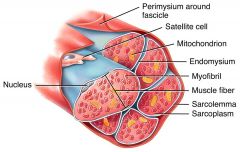
This picture show the organization of a?
|
Organization of a fasciculus
|
|
|
In flexing the forearm at
the elbow, the brachialis is the prime mover or agonists, and the triceps brachii is the? |
antagonist
|
|
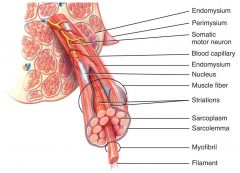
This pirture show the Organization of a?
|
Organization of a muscle fiber
|
|
|
The attachment of a muscle's tendon to the stationary, usually proximal bone, is called the?
|
origin
|
|
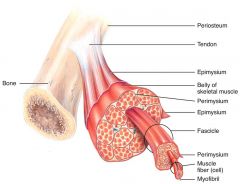
This pic shows A muscle, a fasciculus, and a ____ all visualized
|
fiber
|
|
|
In anatomy, the ____ is a point at which a muscle attaches to a bone. This is the point that tends to be moved by the contraction of the muscle. The opposite end of the muscle is called the origin.
|
insertion
|
|
|
The ____ of the muscle is the thickest part, usually midway beetween the insertion and origin.
|
"belly"
|
|
|
What nervous
system consists of all nervous tissue outside the CNS, including nerves, ganglia, enteric plexuses, and sensory receptors. |
The peripheral nervous
system (PNS) |
|
|
What nervous system consists of the brain and spinal cord?
|
The central nervous system (CNS)
|
|
|
The outermost membrane called the ____ ____, forms a sac that encloses the entire cord.
|
dura mater (tough mother)
|
|
|
The middle membrane of the spinal cord is a delicate avascular covering
called the? It is attached to the inside of the dura and forms the roof of the subarachnoid space |
arachnoid mater.
|
|
|
The transparent membrane of the spinal cord called the ____ ____, is pressed-up against the cord and is filled with blood vessels that supply nutrients to it.
|
pia mater
|
|

Study this pic for the internal structures of the muscle fiber
|
reference only
|
|
|
What are muscles used to prevent unwanted movements at intermediate joints, or otherwise aid the movement of the prime mover.
|
Synergists
|
|
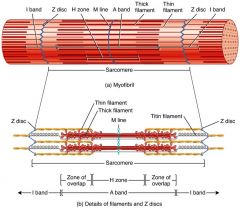
Increasing the level of magnification, the myofibrils are seen to be composed
of filaments Thick filaments and thin Thin filaments Study Pic |
Reference only
|
|
|
What are small masses of neuronal cell bodies located outside the brain and spinal cord, usually closely associated with cranial and
spinal nerves? |
Ganglia
|
|
|
What are multi-protein complexes composed of three different filament systems?
|
Sarcomeres
|
|
|
There are 4 types of neuroglia in the CNS, Astrocytes, Oligodendrocytes, Microglia, and Ependymal cells. Which one of these form and circulate CSF?
|
Ependymal cells
|
|
|
The thick filament system is composed of ____ protein which is connected from the M-line to the Z-disc by titin.
|
myosin
|
|
|
There are 4 types of neuroglia in the CNS, Astrocytes, Oligodendrocytes, Microglia, and Ependymal cells. Which one of these support neurons in the CNS, and Maintain the chemical environment (Ca2+ & K+)?
|
Astrocytes
|
|
|
The thick filament system is composed of myosin protein which is connected from the M-line to the Z-disc by titin. It also contains myosin-binding protein C which binds at one end to the thick filament and the other to?
|
actin
|
|
|
There are 4 types of neuroglia in the CNS, Astrocytes, Oligodendrocytes, Microglia, and Ependymal cells. Which one of these produce myelin in CNS?
|
Oligodendrocytes
|
|
|
The thin filaments are assembled by actin monomers bound to nebulin, which also involves tropomyosin (a dimer which coils itself around the F-actin core of the thin filament) and?
|
troponin
|
|
|
There are 4 types of neuroglia in the CNS, Astrocytes, Oligodendrocytes, Microglia, and Ependymal cells. Which one of these participate in phagocytosis?
|
Microglia
|
|
|
Nebulin and titin give stability and structure to the?
|
sarcomere
|
|
|
There are 2 types of neuroglia in the PNS, Satellite cells, and Schwann cells. Which of these support neurons in PNS?
|
Satellite cells
|
|
|
There are 2 types of neuroglia in the PNS, Satellite cells, and Schwann cells. Which of these produce myelin in PNS?
|
Schwann cells
|
|
|
In the spinal cord, each posterior root has a swelling called the, ____ ____ ____, which contains the cell bodies of sensory neurons.
|
dorsal root ganglion,
|
|
|
What is an area of skin that is innervated by a single spinal nerve, indicated by the letters and number of a particular segmental nerve?
|
A dermatome
|
|
|
What is a fast, involuntary response to a stimulus?
|
A reflex
|
|
|
The ____ ____ ____ contain axons of motor neurons, which conduct nerve impulses from the CNS to
effectors (muscles and glands). |
ventral root ganglion
|
|
|
The “sliding” of actin on myosin (thick filaments on thin filaments) can be broken down into what 4 step process?
|
Step 1: ATP hydrolysis
Step 2: Attachment Step 3: Power Stroke Step 4: Detachment |
|

This step is called?
|
Step 1 ATP hydrolysis
|
|
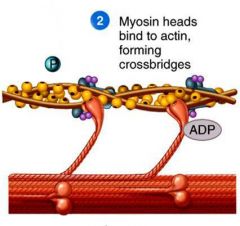
This step is called?
|
Step 2: Attachment
|
|

This step is called
|
Step 3: Power Stroke
|
|
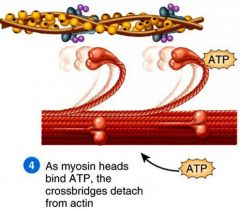
This step is called?
|
Step 4: Detachment
|
|
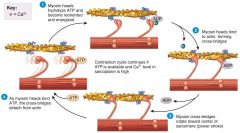
The Sliding-Filament Mechanism.
Study pic |
Reference Only
|
|
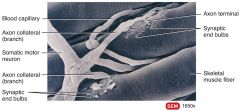
What involves events at the junction between a motor neuron and a skeletal muscle fiber.
|
Excitation-Contraction coupling (EC coupling)
|
|
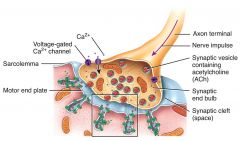
Study Anatomy of NMJ
|
NMJ
|
|

Conscious thought (to move a muscle) results in activation of a motor neuron, and release of the neurotransmitter ____ at the NM junction
|
acetylcholine (AcCh)
|
|

The receptors for AcCh are on the ____-____ ___ channels on the motor end plate
|
ligand-gated sodium channels
|
|
|
Generating an AP on the muscle membrane involves the transfer of information from an ____ signal (down the neuron), to a _____ signal (at the NMJ), back to an ____ signal (depolarization of the sarcolemma).
|
electrical, chemical, electrical
|
|

Excitation-Contraction Coupling Study pic
|
Excitation-Contraction Coupling
|
|
|
Describe Excitation-Contraction Coupling.
|
The thought process going on in the brain
The AP arriving at the neuromuscular junction The regeneration of an AP on the muscle membrane Release of Ca2+ from the sarcoplasmic reticulum Sliding of thick on thin filaments in sarcomeres Generation of muscle tension (work) |
|
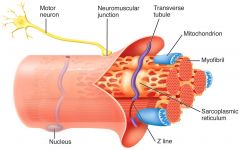
Excitation-Contraction Coupling study pic
|
Excitation-Contraction Coupling
|
|
|
Sources of Muscle Energy are?
|
Stored ATP
Energy transferred from stored creatine phosphate Aerobic ATP production Anaerobic glucose use |
|
|
Stored ATP give about ___ seconds of energy.
|
3
|
|
|
Energy transferred from stored creatine phosphate give about ____seconds of energy
|
12
|
|
|
Anaerobic glucose use give about ____ seconds of energy
|
30-40
|
|
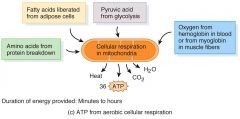
Sources of Muscle Energy
|
Sources of Muscle Energy
|
|
|
In response to a single AP, cardiac muscle contracts 10-15 times longer than ____ muscle, and must continue to do so, without rest, for the life of the individual
|
skeletal
|
|
|
To meet the constant demand, cardiac muscle generally uses the rich supply of O2 delivered by the extensive ____ circulation to generate ATP through aerobic respiration
|
coronary
|
|
|
Like cardiac muscle, smooth muscle (in your deep organs) is ____ and is not under voluntary control
|
autorhythmic
|
|
|
Unlike cardiac (and skeletal muscle) however, smooth muscle has a low capacity for generating ATP and does so only through?
|
anaerobic respiration (glycolysis)
|
|
|
Motor Unit is composed of a motor neuron plus?
|
all of the muscle cells it innervates
|
|
|
A High precision motor unit has?
|
Fewer muscle fibers per neuron
Laryngeal and extraocular muscles (2-20) |
|
|
A Low precision motor unit has?
|
Many muscle fibers per neuron like the Thigh muscles (2,000-3,000)
|
|

Activities requiring extreme precision (like the subtle and rapid movements of the eye) involve muscles with?
|
very small motor units (1-4 muscle fibers/neuron)
|
|
|
Describe the All-or-none principle of muscle contraction.
|
When an individual muscle fiber is stimulated to depolarization, and an action potential is propagated along its sarcolemma, it must contract to it’s full force—it can’t partially contract
|
|
|
When a single motor unit is recruited to contract, all the muscle fibers in that motor unit must?
|
all contract at the same time
|
|
|
Within a particular motor unit all the skeletal muscle fibers are?
|
the same type
|
|
|
The different motor units in a muscle are recruited in a specific order depending on the?
|
task being performed (fast anaerobic activity for maximal force, etc.)
|
|
|
There is a brief delay called the ____ ____ as the AP sweeps over the sarcolemma and Ca2+ ions are released from the sarcoplasmic reticulum (SR).
|
latent period
|
|
|
After the latent periord the next phase is?
|
the fiber is actively contracting
|
|
|
The contracting phase is followed by relaxation as the Ca2+ ions are re-sequestered into the SR and myosin binding sites are covered by?
|
tropomyosin
|
|
|
Temporary loss of excitability is call the ____ ____. All muscle fibers in a motor unit will not respond to a stimulus during this short time
|
refractory period
|
|
|
A ____ is recorded when a stimulus that results in contraction (force) of a single muscle fiber is measured over a very brief millisecond time frame.
|
twitch
|
|
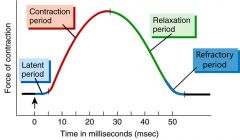
Tension in a Muscle know the phases
|
Tension in a Muscle
|
|
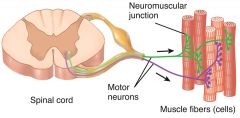
Two motor units, one in green, the other in purple, demonstrate the concept of progressive activation of a muscle known as?
|
recruitment
|
|
|
What is a type of muscle contraction in which the muscle shorten while generating force?
|
Concentric isotonic
|
|
|
What is a contraction in which muscle tension is less than the resistance (the muscle lengthens)?
|
Eccentric isotonic
|
|
|
What contractions results in no movement?
Muscle force and resistance are equal Example: Supporting objects in a fixed position and posture |
Isometric
|
|
|
What refers to how your body is using its fuel -- it means "with oxygen?
|
Aerobic Metabolism
|
|
|
Anaerobic respiration, or metabolism, is performed without?
|
oxygen
|
|
|
Everything done in the nervous system involves what 3 fundamental steps?
|
sensory, interpretation, and A motor response or function occurs
|
|

Nervous System Overview
|
Nervous System Overview
|
|
|
Over 100 billion neurons and 10–50 times that number of support cells (called neuroglia) are organized into two main subdivisions called?
|
The central nevous
system (CNS) The peripheral nervous system (PNS) |
|
|
The central nervous system (CNS) consists of the ____ and ___ ___.
|
brain and spinal cord.
|
|
|
What consists of
all nervous tissue outside the CNS, including nerves, ganglia, enteric plexuses, and sensory receptors? |
The peripheral nervous
system (PNS) |
|
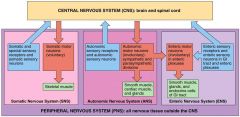
CNS Overview
|
CNS Overview
|
|
|
Somatic sensory are what kind of neurons that convey information from sensory receptors in the head, body wall and limbs towards the CNS.
|
(afferent)
|
|
|
Somatic motor are what kind of neurons that conduct impulses away from the CNS towards the skeletal muscles under voluntary control in the periphery.
|
(efferent)
|
|
|
What are any neurons that conduct impulses between afferent and efferent neurons within the CNS?
|
Interneurons
|
|
|
What are the real “functional unit” of the nervous system, forming complex processing networks within the brain and spinal cord that bring all regions of the body under CNS control?
|
Neurons
|
|
|
Though smaller than neurons, what greatly outnumbers them.
They are the “glue” that supports and maintains the neuronal networks. |
Neuroglia
|
|
|
Though there are several different types of neurons, most have:
|
A cell body
An axon Dendrites Axon terminals |
|
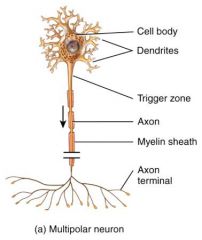
Multipolar neuron
|
Multipolar neuron
|
|
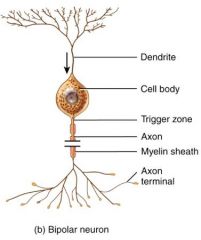
Bipolar Neuron
|
Bipolar Neuron
|
|
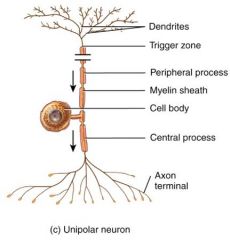
Unipolar Neuron
|
Unipolar Neuron
|
|
|
The site of communication between two neurons or between a neuron and another effector cell is called a?
|
synapse.
|
|
|
The ____ ____is the gap between the pre and post-synaptic cells
|
synaptic cleft
|
|
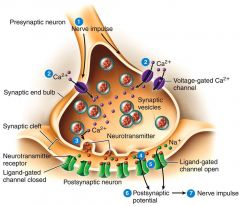
Synaptic Transmission
|
Synaptic Transmission
|
|
|
There are 4 types of neuroglia in the CNS they are?
|
Astrocytes - support neurons in the CNS
Maintain the chemical environment (Ca2+ & K+) Oligodendrocytes - produce myelin in CNS Microglia - participate in phagocytosis Ependymal cells - form and circulate CSF |
|
|
There are 2 types of neuroglia in the PNS the are?
|
Satellite cells - support neurons in PNS
Schwann cells - produce myelin in PNS |
|
|
Like muscle fibers, neurons are electrically excitable. They communicate with one another using two types of electrical signals: They are?
|
Graded potentials are used
for short-distance communication only. Action potentials allow communication over long distances within the body. |
|
|
Propagation of a ___ ____down the length of the axon begins at the trigger zone near the axon hillock.
By passive spread, the current proceeds by (a) continuous conduction in unmyelinated axons, or by the much faster process of (b) saltatory conduction in myelinated axons (as the AP jumps from one node to the next as shown in this graphic). |
Action Potential
|
|
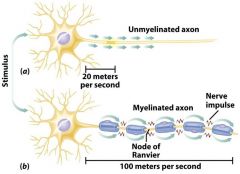
Action Potential
|
Action Potential
|
|
|
How is the impulse transmitted across the synaptic cleft?
|
1.action potential reaches the presynaptic terminal
2.voltage-gated Ca2+ channels open 3.influx of Ca2+ 4.synaptic vesicles fuse with membrane (exocytosis) 5. neurotransmitters are released into synaptic cleft and diffuse to postsynaptic terminal 6. neurotransmitter binds to neuroreceptor on postsynaptic membrane 7. causes Na+ channels to open, and Na+ flows into postsynaptic membrane 8. if threshold is reached then action potential is initiated 9. neurotransmitter is broken down by specific enzymes in the synaptic cleft |
|
|
What transmission involves the release of the neurotransmitter, acetylcholine, and its activation of the postsynaptic receptor. Things that bind to and activate receptors are called agonists. Thus, acetylcholine is the endogenous agonist for all cholinergic receptors.
|
cholinergic
|
|
|
The spinal cord is oval in shape and slightly flattened anteriorly and posteriorly.
Two types of connective tissue coverings protect the cord and provide physical stability, they are? |
The bony vertebral column
and The spinal meninges |
|
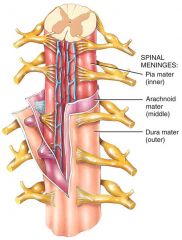
Know the labels
|
Spinal Cord
|
|
|
The outermost membrane of the spinal cord called the ___ ____, forms a sac that encloses the entire cord.
|
dura mater (tough mother)
|
|
|
The middle membrane of the spinal cord is a delicate avascular covering
called the ____ ____. It is attached to the inside of the dura and forms the roof of the subarachnoid space (SAS) in which cerebral spinal fluid (CSF) circulates. |
arachnoid mater
|
|
|
The transparent membrane called the ____ ____, is pressed-up against the cord and is filled with blood vessels that supply nutrients to it.
|
pia mater
|
|
|
The spinal cord and its associated spinal nerves contain ____ ____ that control some of your most rapid reactions to environmental changes.
|
reflex circuits
|
|
|
The ____ matter of the cord is a site for integration of postsynaptic potentials (IPSPs and EPSPs).
|
gray
|
|
|
The ____ matter of the cord contains major sensory and motor tracts to and from the brain.
|
white
|
|

External Cord
|
External Cord
|
|
|
The ____ space runs between the dura mater and the more superficial ligamentum flavum (which lines the underside of the bony vertebral lamina).
|
epidural
|
|
|
The ____ space lies between the dura and the arachnoid.
|
subdural
|
|
|
In the spinal column, the dura and arachnoid membranes are held firmly together so that the subdural
space is often no more than a? |
potential space.
|
|
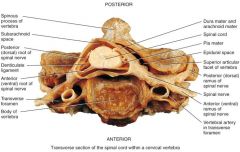
Know Labels
|
Know Labels
|
|
|
The pia mater has 21 pairs of ____ ____ which attach it to the arachnoid and dura maters.
|
denticulate ligaments
|
|
|
The white matter of the cord is divided into anterior, posterior, and lateral columns in which _____sensory tracts are traveling to someplace in the brain and descending motor tracts (red) are traveling to a location in the cord
|
ascending
|
|
|
The _____ tract goes from the spinal cord to the brain – it is an afferent tract.
|
spinothalamic
|
|
|
The ____ tract goes from the cortex of the brain to the spinal cord – it is an efferent tract.
|
corticospinal
|
|
|
The ____ tract originates from an area in the brain which you probably don’t recognize; however, you can recognize the destination in the spine, and therefore deduce that it is a motor tract.
|
vestibulospinal
|
|
|
The ____ columns are afferent tracts that convey nerve impulses for discriminative touch, light pressure, vibration, and conscious proprioception (awareness of tendon and joint position in space and their
relative movements). |
posterior
|
|
|
The ____ tract is an
afferent tract that transmits sensations of pain, warmth, coolness, itching, tickling, deep pressure, and crude touch. |
spinothalamic
|
|

Peripheral Nerves
|
Peripheral Nerves
|
|
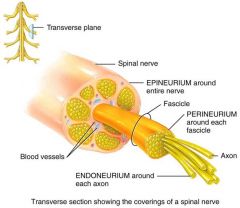
Spinal nerves know labels
|
Spinal nerves
|
|
|
The ____ plexus, formed by the anterior rami of C1-C5, serves the head, neck, and diaphragm.
|
cervical
|
|
|
The brachial plexus is formed by the anterior rami of C5-C8 and T1. The nerves from the brachial plexus supply the?
|
shoulders and upper limbs.
|
|
|
The ____ ____ is formed by the anterior rami of L1-L4 to supply the anterolateral abdominal wall, external genitalia, and part of the lower limbs.
|
lumbar plexus
|
|
|
The ____ and ____ nerves come from the
lumbar plexus. |
femoral and obturator
|
|
|
Spinal reflexes can be ____(sensory neuron with motor neuron) or ____(involving interneurons), and they can go in and out on the same, or on the opposite
side of the cord. |
monosynaptic or polysynaptic
|
|
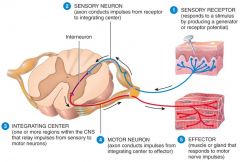
5 Steps of a reflex
|
5 Steps of a reflex
|
|
|
Reflex arcs can be _____ (all neurons and effectors on the same side of the body) or ____ (the receptors and afferent neurons are on the opposite
side of the body as the efferent neurons and effectors.) |
ipsilateral, contralateral
|
|
|
The ____ (withdrawal)
reflex is a good example of a contralateral reflex (stepping on a tack). |
flexor
|
|
|
In addition to initiating the flexor reflex that causes you to withdraw the limb, the pain impulses from stepping
on the tack also initiate a ____ ____ reflex to help you maintain your balance. |
crossed-
extensor |
|
|
The ____ reflex in which the leg extends in response to stretch of the patellar tendon.
|
patellar
|
|
|
The ____ reflex causes contraction of the calf when a force is applied to the Achilles tendon
|
Achilles
|
|
|
The Babinski, or ____ ____ ____is considered normal in adults if they flex (curl) the big toe when the sole of the foot is stimulated.
|
plantar flexion reflex
|
|
|
The spinal ____ surround
the cord as a continuation of the cranial meninges that encircle the brain |
meninges
|
|
|
The primary function of the meninges and of the cerebrospinal fluid is to?
|
protect the central nervous system.
|

